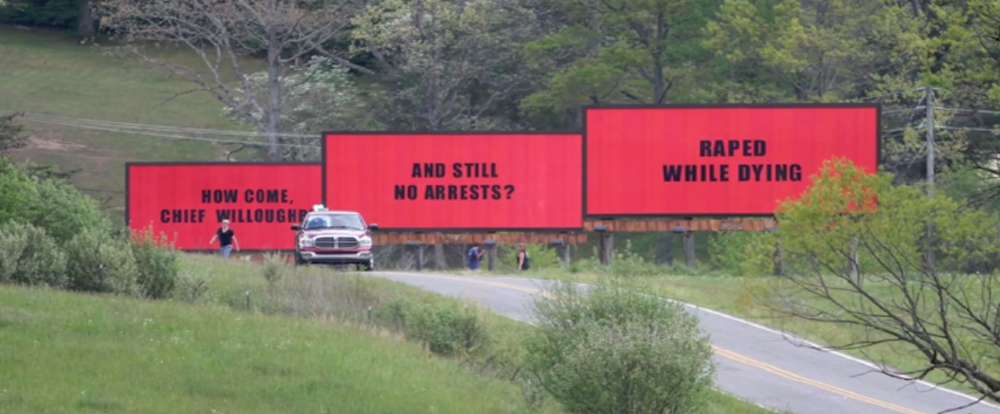
Three Billboards Outside Ebbing, Missouri
Directed & Written by: Martin McDonagh
Starring: Frances McDormand, Woody Harrelson, Sam Rockwell, John Hawkes, Peter Dinklage
/https%3A%2F%2Fblueprint-api-production.s3.amazonaws.com%2Fuploads%2Fcard%2Fimage%2F592193%2Fd2aac214-652f-46a4-bec0-d3bbc1c30e82.jpg)
Three Billboards Outside Ebbing, Missouri is both new ground and a homecoming for writer-director Martin McDonagh. Before he launched his filmmaking career, McDonagh wrote plays. Many took place in his native Ireland. All of them boasted dark humor, intense characters, and emotionally taxing action leading to uncertain endings. In sharp contrast to his surreal, hilarious 2008 masterpiece In Bruges, Three Billboards is the film of McDonagh’s that most recalls his stage work. He moves the action to the American heartland, but this is appropriate. America in 2017 is a messy, complex place, and this is a messy, complex movie.
Three Billboards wastes no time and establishes the plot within the first five minutes. Gift shop proprietor Mildred Hayes loses her daughter to an unspeakable tragedy. When the Ebbing police cannot apprehend those responsible, Mildred buys the titular three billboards and calls them out. (McDonagh clearly watches the news from Missouri—Mildred declares the police would rather torture black prisoners than solve crimes.) Sheriff Bill Willoughby takes this in stride as he deals with his own problems. However, the billboards infuriate Willoughby’s loyal, racist deputy Jason Dixon. Mildred refuses to stand down, and things, as they say, escalate quickly.
THE STARS
 McDonagh’s three main leads exemplify the strengths and weaknesses of his film. Frances McDormand gives a performance for a lifetime as Mildred Hayes. With her wrinkled, penetrating stare, McDormand is silly, scary, profane, and occasionally deeply moving. Most importantly, in McDormand’s wise hands, Mildred becomes the “strong female character” we want and need. There are many occasions in the film when she does terrible, almost villainous things. While the audience condemns her, they remain on her side because her motivations are well understood. McDormand’s crackling warmth ensures that. (She receives immeasurable help from Lucas Hedges as her withdrawn, embarrassed, but supportive son.)
McDonagh’s three main leads exemplify the strengths and weaknesses of his film. Frances McDormand gives a performance for a lifetime as Mildred Hayes. With her wrinkled, penetrating stare, McDormand is silly, scary, profane, and occasionally deeply moving. Most importantly, in McDormand’s wise hands, Mildred becomes the “strong female character” we want and need. There are many occasions in the film when she does terrible, almost villainous things. While the audience condemns her, they remain on her side because her motivations are well understood. McDormand’s crackling warmth ensures that. (She receives immeasurable help from Lucas Hedges as her withdrawn, embarrassed, but supportive son.)
Woody Harrelson similarly excels as Willoughby. While the world of Three Billboards grows broad and hyperactive, Harrelson acts with understatement. Much of Willoughby’s action involves soft-spoken musings and firm, quiet posturing—with one crucial exception. In one of many nods to McDonagh’s stage background, Three Billboards includes several long speeches. Harrelson delivers several of the longest with charming grace.
The third main character, Dixon, represents the film’s problematic qualities. Dixon transforms throughout the movie from a doofus to a force of violence to a man capable of redemption. The tonal shifts are melodramatic at best, jarring at worst. Thankfully, Sam Rockwell commits to the part and happily dives into everything required of him. Even so, Dixon’s actions during the final minutes feel too unbelievable a sea change from where he started.
THE CAST
Three Billboards fills the rest of the cast with hits, misses, one-note supporting roles, and bizarre choices. Two great character actors receive feature billing for small parts. One, John Hawkes as Mildred’s ex-husband, is terrific and well-served. Hawkes fully fleshes out his character and augments him into the story in only a few scenes. (Samara Weaving plays his 19-year-old new girlfriend and gets some of the biggest laughs with her deadpan humor.)
The other, Peter Dinklage, gives a winning performance–but the screenplay fails him. Dinklage’s character, a car salesman with a crush on Mildred, never feels integrated into the action. He flits in and out, and almost all of his character work comes in one short burst of dialogue.
If Dinklage is wasted, Abbey Cornish is head-scratching as Willoughby’s devoted wife. Cornish is good, but she makes one wonder how this Englishwoman married a Midwest sheriff two decades her senior.
THE STORYTELLING
 Three Billboards, McDonagh’s third feature, reveals his growth as a director. His pictorial sense (aided by cinematographer Ben Davis) is assured and flowing. His camera moves and always finds the most interesting elements on which to focus. However, his screenplay, while full of his magnificent comedic gifts, is not his best.
Three Billboards, McDonagh’s third feature, reveals his growth as a director. His pictorial sense (aided by cinematographer Ben Davis) is assured and flowing. His camera moves and always finds the most interesting elements on which to focus. However, his screenplay, while full of his magnificent comedic gifts, is not his best.
It annoyed me that Three Billboards makes racism a talking point in Mildred’s quest but pushes its black characters to the margins. All of them are portrayed as good, uncomplicated figures compared to the rest of Ebbing.
However, the structure of the screenplay truly does the film no favors. I mentioned earlier how it recalls McDonagh’s plays, and it carries some of the unreality of live theatre. There are plenty of speeches and unrealistic monologues. The tone and the characters’ attitudes shift with no good understanding of why. And the third act turns on a head-shaking number of coincidences.
This said, few people alive write like McDonagh. And even when the material falls flat, his cast delivers. Three Billboards Outside Ebbing, Missouri is an original vision of the sort Hollywood should try to make more of.
THE VERDICT:
See it! The movies offers a multitude of laughs and thoughts, so that you can look past the flaws.

![[REVIEW] ‘THE BEAUTIFUL ONES’ BLENDS LOVE AND MAGIC IN THIS CHARMING HISTORICAL ROMANCE](https://geekd-out.com/wp-content/uploads/2021/04/BeautifulOnesCover-150x150.jpg)


One thought on “Review: Three Billboards Outside Ebbing, Missouri”